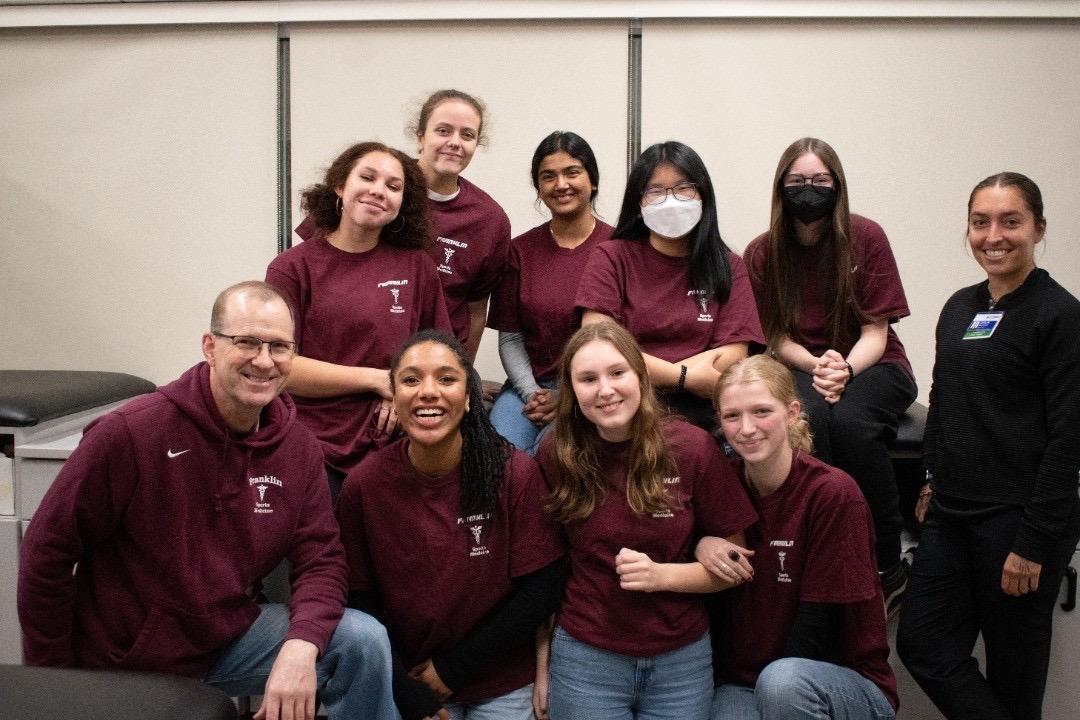Behind every healed ankle sprain, muscle strain, and tendon injury at Franklin are multi-skilled professional trainers, and… high school students. The Sports Medicine Clinic (also known as Sports Medicine 5-6) is an after-school program for Franklin students who have completed two years of the Sports Medicine courses, both Sports Medicine 1-2 and Sports Medicine 3-4.
Sports Medicine 1-2 is an introductory course to sports medicine that includes medical terminology, anatomy, physical therapy, emergency care, and common athletic injuries. In Sports Medicine 3-4, students learn how to treat and evaluate common athletic injuries. In Sports Medicine 5-6, students get to observe, assist, and shadow the athletic trainer with the evaluation and treatment of Franklin athletes. The students are graded by their attendance at the after-school meetings and their on-site game observation journals.
The Sports Medicine program is taught by Dave Sherden and Rick Holte. The Sports Medicine Clinic is led by Sherden, who previously worked as an athletic trainer for 30 years, alongside Franklin’s current certified athletic trainer, Gerilyn Armijo, who students shadow during games.
Aside from having to complete Sports Medicine 1-2 and 3-4, students must also undergo an application process that mainly focuses on the student’s time commitment to the program, their dependability, and if they are responsible and mature enough to be put on the field and be entrusted with the athletes’ medical conditions. “I try to make sure upfront that everybody understands the time commitment and efforts that are involved [with Sports Med Clinic]” Sherden explains.
The clinic was designed for students to have authentic hands-on experience, and to give them a chance to work on real athletic injuries instead of just discussing theoretical medical scenarios. Students can observe Armijo in the treatment center while she performs injury and concussion evaluations, does wound cleanings, and tends to various athletic-related skin conditions. Most importantly, the students are trained in basic first aid to prepare them to work in action with Armijo during games.
“For games, most of the time there aren’t major injuries but we help with cuts and scrapes, we’re all not certified but we are trained on how to take care of first aid,” explains returning clinic student Ruth von Fortune (12). “Last year we learned how to tape ankles, so I can tape ankles. Then over the summer, I helped [the athletic trainer] with the summer athletics stuff so she taught me how to do other tapings. I would do the basic taping and [she] would do the advanced taping.”
However, for first-year students, like Ngoc Le (12), taping and wrapping athletes isn’t allowed yet. “During treatment centers, which is spending an hour a week in [the trainer’s] room, we just observe whoever comes in [since] I am not qualified enough to help them wrap stuff.” Le also expressed her worries prior to taking this class: “I thought it would be boring, but it’s way more interesting [than I expected]. I don’t regret taking this at all, this is not a waste of after-school time.”
According to another second-year clinic student, Rowan Cook-Diaz (12), aside from helping Armijo prep and observe obvious symptoms and risks, they also seek out injuries that the athletic trainer might have missed.
Apart from exposing sports medicine students to the interconnecting issues of athletic training and medical injuries such as concussions, injuries, illnesses, skin conditions and mental health conditions, Armijo also serves as a mentor and outlet for student-athletes since she was one herself too. Armijo played soccer for two decades, including college soccer. She had her fair share of injuries and stress from balancing sports, academics and social life.
“I don’t think people understand how hard it is to be a student-athlete unless you’ve been there,” Armijo states. She talks about how her exchange of experiences with students alleviates their concerns, not just because of her background in medicine but also as a student-athlete. “Being somebody that they could relate to, or somebody that has been in their shoes before [is my favorite part of my job].”
Sherden and Armijo both asserted that the Sports Medicine Clinic program is a great extracurricular to state on college applications. The program shows that students have applied the knowledge and skills they acquired in the classroom to real patient-care situations. “It encompasses so many different things and I think a big [and] huge thing is getting a history of how a patient ended up in your clinic. That is valid for every healthcare professional,” Armijo states. “That’s one thing [students] get to learn here; how to get a proper history and listen to their patients.”
The Sports Medicine Clinic is a perfect course for students interested in majoring in medicine and healthcare or aspiring to study Sports Medicine in the future.


































